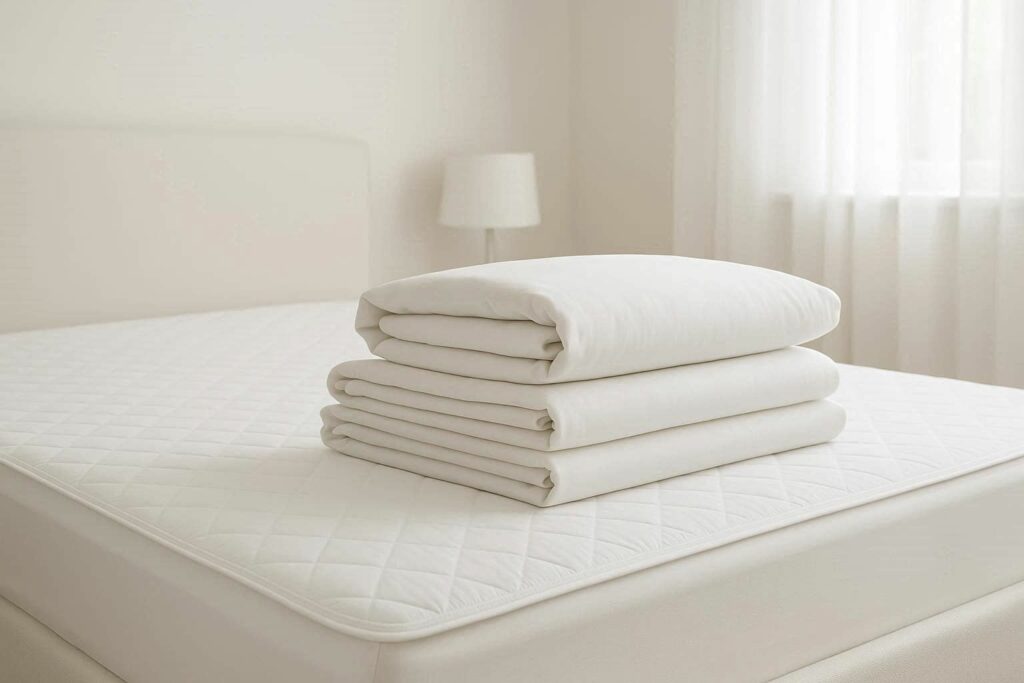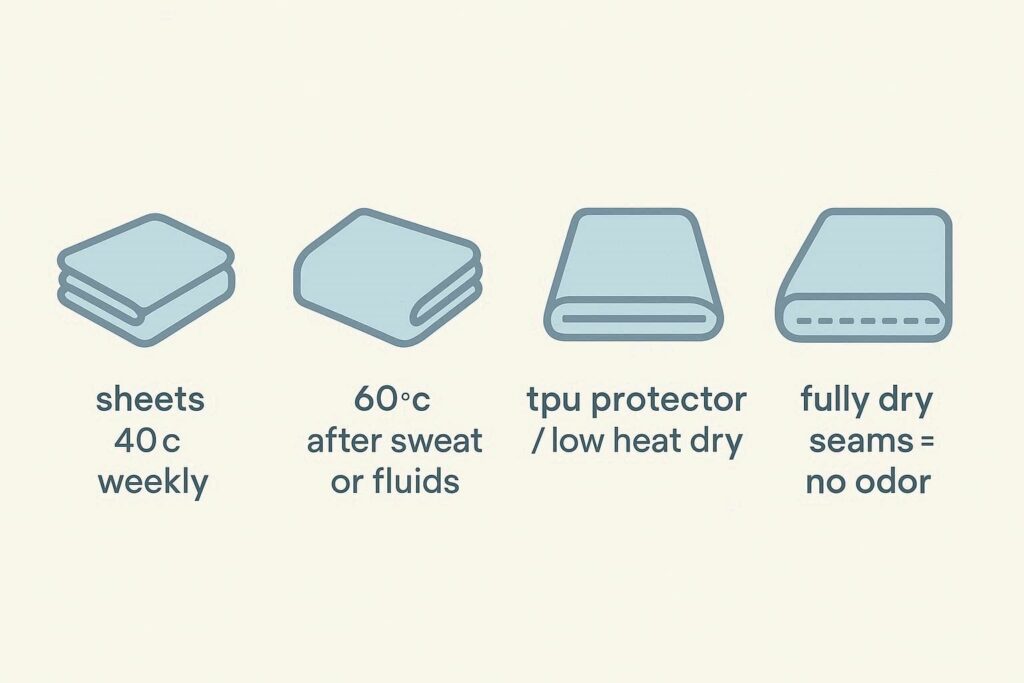Goal:
You want clean sheets, no smell, no bio stains, no allergens — but you don’t want to destroy your waterproof protector or shrink your removable mattress cover.
This guide gives you:
- When 40°C is enough and when you actually need 60°C
- How to wash a waterproof mattress protector without killing the membrane
- How to dry things so they don’t start to smell again the next night
- A simple rotation routine that works in rentals, Airbnb, kids, pets

1. Why temperature matters (and why 30°C “gentle wash” is often useless)
Let’s be blunt:
- 30°C with “delicate detergent” = mostly cosmetic refresh. Smell may stay. Skin oils stay. Allergens stay.
- 40°C is fine for normal sweat, light use, no visible accidents.
- 60°C is the level where you start actually removing body fluids, pet traces, dust mites, and that sour “used pillowcase” smell.
When you sleep, you leave:
- sweat and skin oils,
- saliva,
- dead skin,
- sometimes body fluids (kids, period, pets),
- odor.
If you keep washing cold forever, you’re not disinfecting. You’re perfuming dirt.
Rule of thumb:
- Light normal adult use → 40°C is usually okay.
- Anything “biological” (kids, night sweat, pets, accidents) → you go to 60°C if the fabric allows it.
But — and this is important — not every fabric and not every protective layer survives 60°C. Keep reading.
2. Sheets, pillowcases, duvet covers: what cycle to use
For standard bedding (cotton percale, cotton sateen, Tencel/lyocell blends, etc.):
Wash cycle:
- 40°C for normal weekly wash.
- 60°C if there was sweat, body fluid, smell, sickness, or guest turnover.
Spin speed:
- 800–1000 rpm is fine for most sheets.
- Higher spin = dries faster but can wrinkle/beat the fabric harder long term.
Drying:
- Tumble dry “Medium” is usually okay for cotton.
- Remove when still slightly damp and air-finish it → less harsh, less crunchy, less “old hotel smell.”
- Do not over-dry to “crispy hot.” Over-dried fabric tends to trap smell faster next time and feels hotter against the skin.
For Tencel / lyocell blends:
- Still okay at 40°C.
- 60°C only if the label explicitly says it’s allowed. Lyocell can lose softness if overheated repeatedly.
- Tencel hates aggressive high-heat drying. Use low/medium dry or hang.
Bottom line:
Weekly 40°C is fine for normal adults.
60°C is not “overkill,” it’s actually the correct answer for stains, body fluids, guests, pets.

3. Waterproof mattress protector: how not to destroy it
This is the part most people get wrong.
A good waterproof protector for a mattress should use a thin TPU membrane (thermoplastic polyurethane), not a loud plastic sheet.
TPU membrane does two things:
- Blocks liquid (urine, sweat, wine, etc.)
- Still lets some moisture vapor escape, so you don’t sleep in a sauna
But TPU is sensitive to:
- high wash temperature,
- harsh bleach,
- fabric softener (it clogs the membrane),
- high dryer heat.
How to wash a TPU-backed protector:
- 40°C is safe for most protectors.
- 60°C is often allowed, but you have to check the care label. Some membranes tolerate 60°C, some start degrading and peeling.
- Spin speed ~600–800 rpm is enough. You don’t need brutal spin.
Absolutely avoid:
- Chlorine bleach. It burns the membrane long-term.
- Fabric softener. It coats the membrane so it “stops breathing,” and then people complain “it feels sweaty now.”
- High heat tumble dry. High heat bakes the TPU, makes it stiff and noisy.
Drying:
- Low heat tumble dry OR air dry fully.
- “Almost dry is fine” = wrong. You need it dry inside the seams. Otherwise, odor grows inside the hem and comes back later even if the surface smells okay.
If the protector starts smelling even after washing, or the membrane is flaky / stiff / noisy like plastic → you’re done. Replace it. Do not try to “perfume it back to life.” It won’t come back.
4. Removable mattress cover (zip cover): careful here
Some mattresses come with a removable outer cover (full zip, full encasement). People think “I’ll just wash it hot.” That’s where they ruin it.
Reality:
- Most removable covers are not meant for hot wash. 30–40°C is common.
- High spin + high heat = warping, shrink, twisted zipper line.
- If you shrink/warp that cover, it will never sit flat on the mattress again. It will bunch, wrinkle, and scream “this mattress is old and gross,” even if it’s not.
How to handle removable covers:
- Only wash if needed (visible spot, odor, sickness, guest turnover with suspicion). Not every single week.
- Follow the label strictly. If it says 30°C delicate, do 30°C delicate. Don’t macho your way through.
- Dry low heat or air dry flat. Do not twist, do not hang it by one corner dripping — it will stretch weird.
If the removable cover keeps smelling after a proper low-temp wash and full dry, that usually means liquid got through to the inside of the mattress core. At that point, you’re not “cleaning.” You’re evaluating replacement.
5. Drying: this is where people either win or lose
Half-clean + half-wet = mold smell tomorrow.
Drying checklist:
- Sheets and pillowcases: OK to finish in dryer on Medium, but don’t bake them to bone-dry heat. Finish in air = softer feel, less stale odor.
- TPU waterproof protector: dry on Low or air dry. Then confirm seams are fully dry. Seams = bacteria trap if damp.
- Mattress cover (zip cover): air dry flat or very low tumble. Respect the zipper line.
Never:
- Throw slightly damp bedding straight back on the mattress and make the bed “for later.” That “later” smell becomes permanent “old fabric” smell.
- Store damp/warm protectors in a closed wardrobe. You’ll grow odor, then put that odor directly on the next sleeper.
6. Rotation system: the “2+1” method that keeps rentals and family beds under control
This applies if you:
- run Airbnb / host guests,
- have kids,
- have pets on the bed,
- or you just want the bed to smell like “clean” every time without drama.
System:
- You own 2 waterproof protectors and 2 full bedding sets for 1 bed.
- One set is on the bed.
- One set is clean, folded, ready.
- After a “dirty event” (night sweat, kid accident, pet accident, guest checkout), you strip everything immediately and swap to the clean spare set.
- The dirty set goes straight to wash/dry on the right settings without panic and without having to rush it back on the bed half-dry.
Why this matters:
- You never “seal in” odor by reusing a damp protector.
- You never leave stains sitting overnight and oxidizing.
- You’re not tempted to say “eh, it’s fine for one more night” — because you already have the backup on hand.
This is also what separates a place that feels “clean rental” from “cheap rental.” Guests 100% notice.
7. What destroys bedding long-term (and makes it smell worse, not better)
Mistakes to stop doing:
- Overheating everything at max temp every single wash “for hygiene.” You cook elastic, membranes, and surface finish, so they trap odor faster next time.
- Pouring bleach on protein stains (blood, sweat). That can set the stain permanently and wreck fibers.
- Using fabric softener on waterproof protectors. You choke the membrane, then complain it’s “sweaty plastic.”
- Putting stuff away still a little damp “just for now.”
One more red flag:
- If you keep smelling “old sweat / damp dog” even after following proper wash + dry, the problem might not be the bedding anymore. It might be the mattress core or the base (no ventilation, moisture trapped under the mattress). That’s a different problem — humidity and airflow, not laundry.
Table: wash and dry cheat sheet
You can paste this as a table block in WordPress.
| Item | Wash temp | Spin speed | Drying method | Watch out for |
|---|---|---|---|---|
| Sheets / pillowcases (cotton) | 40°C normal use / 60°C body fluids | 800–1000 rpm | Tumble Medium or air finish | Don’t over-dry to “crispy hot” |
| Tencel / lyocell bedding | 40°C | ~800 rpm | Low / air dry | High heat can make it rough and weaker |
| Waterproof mattress protector (TPU) | 40°C (60°C only if label allows) | 600–800 rpm | Low heat tumble or air, fully dry seams | No bleach, no fabric softener, no high heat |
| Removable mattress cover (zip) | 30–40°C delicate | 400–800 rpm | Low tumble or flat air dry | Shrink/warp ruins the fit |
| Duvet cover after guest turnover | 60°C if allowed | 800–1000 rpm | Medium dry, finish in air | You need full odor removal, not perfume |
Bottom line
- 40°C is fine for “normal week.”
- 60°C is not overkill — it’s required if there’s sweat, body fluids, pets, guests.
- Waterproof protectors with TPU are great, but only if you don’t cook them and don’t poison them with fabric softener.
- Everything has to be fully dry (especially seams) before going back on the bed. “Almost dry” = smell.
- Run a 2+1 rotation (two full sets per bed), so you’re never forced to reuse damp or borderline bedding.
Clean bedding is not about “nice smell.” It’s about hygiene, not ruining fabrics, and not letting odor become permanent.